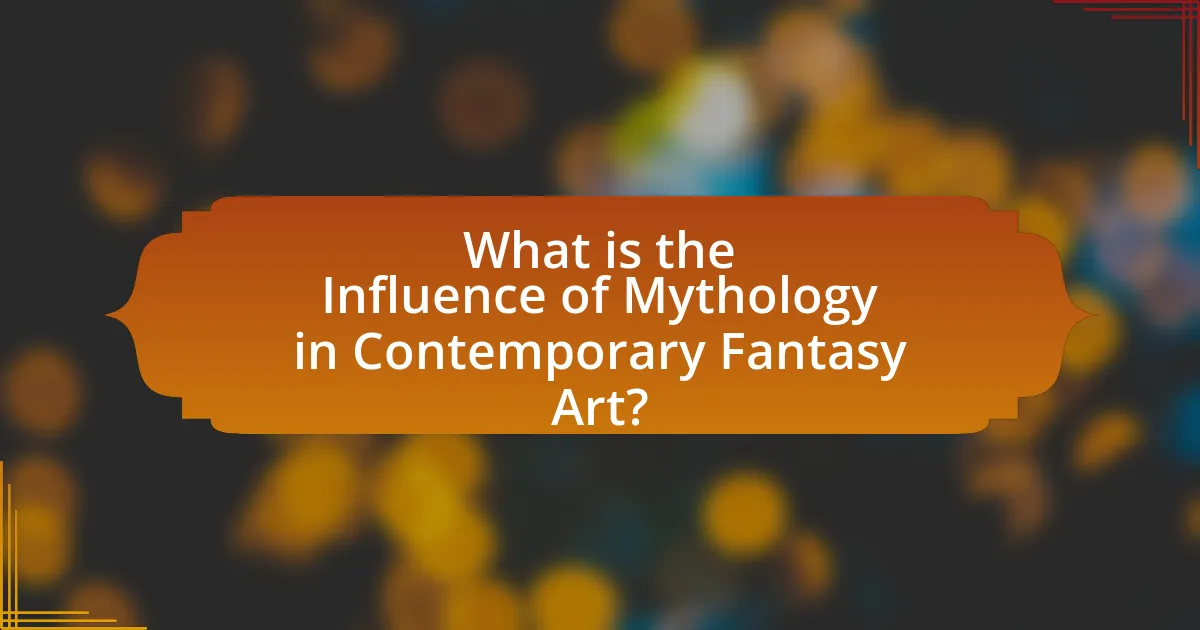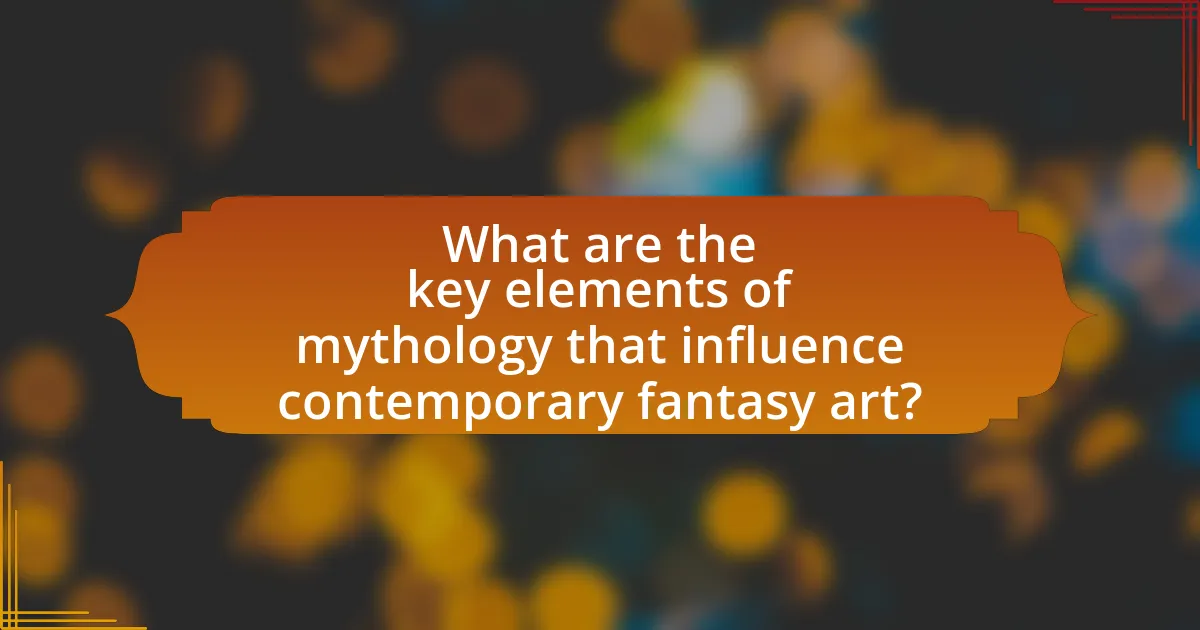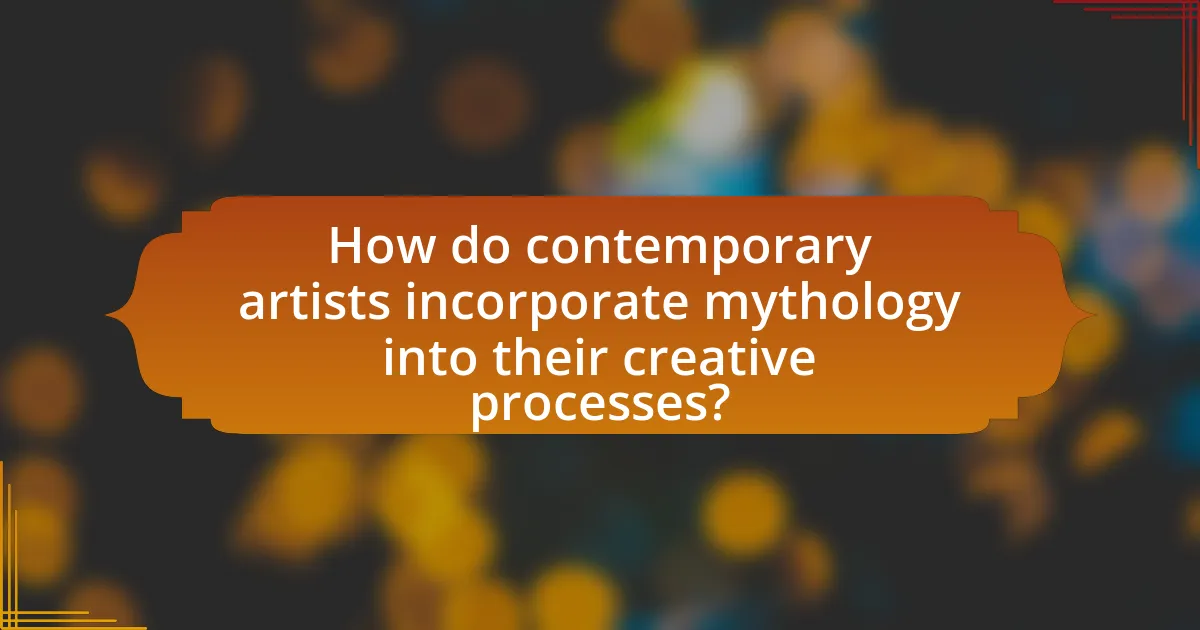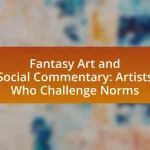The article examines the significant influence of mythology on contemporary fantasy art, highlighting how artists utilize mythological narratives, archetypes, and symbols to enhance their visual storytelling. It discusses the themes shaped by mythology, such as heroism and morality, and identifies frequently referenced mythological stories from various cultures, including Greek, Norse, and Egyptian legends. The article also explores how artists interpret these themes, the role of mythical creatures, and the techniques used to integrate mythological elements into their work, while addressing cultural sensitivities and common misconceptions. Overall, it emphasizes the enduring relevance of mythology in enriching contemporary artistic expression and fostering cross-cultural dialogue.

What is the Influence of Mythology in Contemporary Fantasy Art?
Mythology significantly influences contemporary fantasy art by providing rich narratives, archetypes, and visual motifs that artists draw upon. Artists often incorporate mythological themes to evoke emotions and connect with cultural histories, as seen in the works of creators like Brian Froud and Julie Bell, who utilize mythic creatures and legendary tales to enhance their visual storytelling. This connection is evident in the prevalence of mythological figures, such as gods and heroes, in modern illustrations and digital art, reflecting a continuity of cultural storytelling that resonates with audiences. Furthermore, studies indicate that the integration of mythological elements in art can deepen viewer engagement, as these familiar symbols and stories tap into collective memory and shared human experiences.
How has mythology shaped the themes in contemporary fantasy art?
Mythology has significantly shaped the themes in contemporary fantasy art by providing a rich source of archetypes, narratives, and symbolism. Artists often draw upon mythological figures and stories, such as gods, heroes, and mythical creatures, to explore universal themes like good versus evil, creation, and transformation. For instance, the use of Greek mythology in modern illustrations can be seen in works that depict characters like Medusa or Hercules, which resonate with contemporary audiences due to their timeless moral dilemmas and emotional depth. Additionally, the incorporation of mythological elements allows artists to create immersive worlds that reflect cultural heritage and collective human experiences, thereby enhancing the emotional and intellectual engagement of viewers.
What specific mythological stories are most frequently referenced in contemporary fantasy art?
Contemporary fantasy art frequently references mythological stories such as the Greek myths of Hercules, the Norse tales of Odin and Thor, and the Egyptian legends surrounding Osiris and Isis. These stories are popular due to their rich narratives and archetypal characters, which resonate with themes of heroism, conflict, and transformation. For instance, the story of Hercules’ twelve labors is often depicted to symbolize strength and perseverance, while Norse mythology’s Ragnarok serves as a dramatic backdrop for themes of destruction and rebirth. The enduring appeal of these mythologies in art is evidenced by their consistent presence in exhibitions and popular culture, illustrating their significant influence on contemporary artistic expression.
How do artists interpret mythological themes in their work?
Artists interpret mythological themes in their work by reimagining ancient stories and symbols to reflect contemporary issues and personal experiences. For instance, many artists draw on mythological figures, such as gods and heroes, to explore themes of identity, power, and morality, thereby making these timeless narratives relevant to modern audiences. A notable example is the use of Greek mythology in contemporary art, where artists like Kehinde Wiley incorporate figures from classical mythology into modern contexts, challenging traditional representations and highlighting social issues. This approach not only preserves the cultural significance of these myths but also invites viewers to engage with them in new and meaningful ways.
Why is mythology significant in the context of fantasy art?
Mythology is significant in the context of fantasy art because it provides a rich source of themes, symbols, and narratives that artists can draw upon to create compelling visual stories. The incorporation of mythological elements allows artists to tap into universal human experiences and emotions, making their work resonate on a deeper level with audiences. For example, the use of figures like gods, heroes, and mythical creatures can evoke a sense of wonder and exploration, which are central to the fantasy genre. Additionally, many contemporary fantasy artists, such as Brian Froud and Julie Bell, have explicitly referenced mythological sources in their works, demonstrating how these ancient stories continue to inspire and shape modern artistic expression.
What cultural values are reflected through the use of mythology in fantasy art?
Mythology in fantasy art reflects cultural values such as heroism, morality, and the relationship between humanity and nature. These values are often depicted through archetypal characters and narratives that resonate with collective cultural beliefs. For instance, the portrayal of heroes in fantasy art often embodies ideals of bravery and sacrifice, mirroring the cultural emphasis on valor found in various mythologies, such as the Greek tales of Hercules or the Norse legends of Thor. Additionally, fantasy art frequently explores themes of good versus evil, which are rooted in moral frameworks established by cultural narratives. The representation of nature, often as a mystical or powerful force, highlights the cultural reverence for the environment, seen in works inspired by indigenous mythologies that emphasize harmony with nature. These elements demonstrate how fantasy art serves as a medium for expressing and preserving cultural values through the lens of mythology.
How does mythology enhance the narrative depth of fantasy art?
Mythology enhances the narrative depth of fantasy art by providing rich, archetypal stories and characters that resonate with universal human experiences. These mythological elements serve as a foundation for complex themes such as heroism, morality, and the struggle between good and evil, which are often depicted in fantasy art. For instance, the use of figures like gods, monsters, and legendary heroes from various mythologies allows artists to explore profound emotional and philosophical questions, making the artwork more relatable and impactful. This connection to mythology not only deepens the viewer’s engagement but also situates the fantasy art within a broader cultural and historical context, enriching its narrative significance.

What are the key elements of mythology that influence contemporary fantasy art?
Key elements of mythology that influence contemporary fantasy art include archetypal characters, symbolic motifs, and narrative structures. Archetypal characters, such as heroes, tricksters, and gods, serve as foundational figures that resonate with audiences, drawing from universal themes found in myths across cultures. Symbolic motifs, like dragons, phoenixes, and other mythical creatures, provide visual elements that evoke deeper meanings and emotions, often representing transformation, power, or the struggle between good and evil. Narrative structures derived from mythology, such as the hero’s journey, guide the storytelling aspect of fantasy art, allowing artists to create compelling and relatable narratives. These elements are evident in the works of contemporary artists who often reference ancient myths, demonstrating the enduring impact of mythology on modern creative expression.
Which mythological archetypes are prevalent in contemporary fantasy art?
Contemporary fantasy art prominently features mythological archetypes such as the hero, the trickster, and the wise old man. The hero archetype is often depicted in various forms, representing bravery and the quest for identity, as seen in artworks inspired by figures like Hercules or King Arthur. The trickster archetype, exemplified by figures such as Loki or Hermes, introduces themes of chaos and transformation, often challenging societal norms. The wise old man, represented by characters like Merlin or Gandalf, embodies wisdom and guidance, serving as a mentor to the hero. These archetypes resonate with audiences due to their deep-rooted presence in cultural narratives, reinforcing the connection between mythology and contemporary artistic expression.
How do these archetypes manifest in character design and storytelling?
Archetypes manifest in character design and storytelling by providing recognizable patterns that shape characters’ traits, motivations, and narratives. For instance, the hero archetype often embodies qualities such as bravery and self-sacrifice, which can be seen in characters like Frodo Baggins from “The Lord of the Rings,” who embarks on a perilous journey to destroy the One Ring. This archetype not only influences the visual design—often depicting the hero in a way that emphasizes their strength and resolve—but also drives the plot forward through their challenges and growth. Additionally, the mentor archetype, exemplified by characters like Gandalf, serves to guide the hero, reinforcing the narrative structure and thematic elements of wisdom and guidance. Such archetypes are rooted in mythology, as Joseph Campbell’s “The Hero with a Thousand Faces” illustrates the universal patterns found in myths across cultures, demonstrating their enduring impact on contemporary storytelling and character design.
What role do mythical creatures play in contemporary fantasy art?
Mythical creatures serve as central symbols and thematic elements in contemporary fantasy art, embodying cultural narratives and human emotions. These creatures, such as dragons, unicorns, and griffins, are often used to explore complex themes like heroism, conflict, and the supernatural, allowing artists to convey deeper meanings and evoke emotional responses. For instance, the prevalence of dragons in fantasy art can be traced back to various mythologies, where they represent power and chaos, thus enriching the visual storytelling in modern artworks. This connection to historical and cultural contexts reinforces the significance of mythical creatures in shaping contemporary artistic expressions.
How do different cultures’ mythologies contribute to contemporary fantasy art?
Different cultures’ mythologies significantly contribute to contemporary fantasy art by providing rich narratives, archetypes, and visual motifs that artists draw upon for inspiration. For instance, the use of Norse mythology in contemporary works often features gods like Thor and Loki, which can be seen in popular media such as Marvel comics and films, illustrating how ancient stories are reinterpreted for modern audiences. Additionally, elements from African, Asian, and Indigenous mythologies introduce diverse perspectives and themes, enriching the fantasy genre with unique characters and settings. The incorporation of these mythologies not only enhances the storytelling aspect of fantasy art but also fosters cross-cultural dialogue, as seen in the works of artists like Yoshitaka Amano, who blends Japanese folklore with fantasy elements. This blending of mythological sources creates a tapestry of cultural narratives that resonate with a global audience, demonstrating the enduring relevance of these ancient stories in contemporary artistic expression.
What are examples of cross-cultural influences in fantasy art?
Cross-cultural influences in fantasy art include the incorporation of mythological elements from various cultures, such as the use of Norse gods in contemporary illustrations, which reflects the influence of Scandinavian mythology. Additionally, Asian motifs, like dragons from Chinese folklore, are frequently depicted in fantasy artworks, showcasing the blending of Eastern and Western artistic traditions. The use of African tribal patterns and symbolism in character design further exemplifies this cross-cultural exchange, highlighting the global nature of fantasy art. These examples demonstrate how artists draw inspiration from diverse mythologies to create rich, multifaceted visual narratives.
How do artists blend various mythologies to create unique works?
Artists blend various mythologies to create unique works by integrating symbols, narratives, and characters from different cultural traditions into cohesive visual representations. This practice allows artists to explore universal themes such as heroism, morality, and the human experience while drawing on the rich tapestry of diverse mythological sources. For instance, contemporary artists like Kehinde Wiley incorporate elements from African, European, and Asian mythologies, creating a dialogue between cultures and challenging traditional narratives. This blending not only enriches the artwork but also invites viewers to engage with multiple cultural perspectives, fostering a deeper understanding of shared human experiences.

How do contemporary artists incorporate mythology into their creative processes?
Contemporary artists incorporate mythology into their creative processes by reinterpreting ancient narratives and symbols to explore modern themes and personal experiences. For instance, artists like Kehinde Wiley and Yinka Shonibare utilize mythological references to address issues of identity, race, and power dynamics in contemporary society. This approach not only revitalizes traditional stories but also makes them relevant to current cultural dialogues, as seen in Wiley’s portraits that blend classical European art with African heritage. By merging mythological elements with contemporary contexts, these artists create works that resonate with audiences on multiple levels, bridging the past and present.
What techniques do artists use to integrate mythological elements into their art?
Artists integrate mythological elements into their art through techniques such as symbolism, narrative storytelling, and the use of archetypes. Symbolism allows artists to convey complex ideas and themes associated with myths, using specific colors, shapes, or objects that represent deeper meanings. For instance, the use of a serpent can symbolize transformation or danger, as seen in various mythologies. Narrative storytelling is employed to depict mythological tales, often illustrating key moments or characters, which helps viewers connect emotionally with the artwork. Additionally, artists utilize archetypes—universal symbols or characters that recur across cultures—to evoke familiar mythological themes, such as the hero’s journey or the trickster figure. These techniques not only enrich the visual experience but also invite viewers to explore the cultural and historical contexts of the myths represented.
How does research into mythology inform an artist’s work?
Research into mythology significantly informs an artist’s work by providing rich narratives, symbols, and archetypes that enhance creative expression. Artists often draw upon mythological themes to explore universal human experiences, such as love, conflict, and transformation, which resonate with audiences. For instance, the use of Greek mythology in contemporary art allows artists to reinterpret ancient stories, as seen in the works of artists like Kehinde Wiley, who incorporates mythological figures to comment on modern identity and culture. This connection to mythology not only deepens the thematic complexity of the artwork but also engages viewers through familiar cultural references, thereby enriching the overall artistic experience.
What mediums are commonly used to express mythological themes in fantasy art?
Common mediums used to express mythological themes in fantasy art include painting, digital art, sculpture, and illustration. Painting, particularly oil and acrylic, allows for rich color and texture, enabling artists to depict intricate mythological scenes. Digital art has gained prominence due to its versatility and accessibility, allowing for dynamic representations of mythological narratives. Sculpture, often in materials like clay or bronze, provides a three-dimensional perspective on mythological figures and stories. Illustration, especially in books and comics, serves to visually narrate mythological tales, making them accessible to a broader audience. These mediums collectively enhance the storytelling aspect of mythology in contemporary fantasy art.
What challenges do artists face when drawing from mythology?
Artists face several challenges when drawing from mythology, primarily related to interpretation, cultural context, and accuracy. The interpretation of mythological themes can vary significantly across cultures and time periods, leading to potential misrepresentation. Additionally, artists must navigate the cultural significance of mythological figures and stories, ensuring they respect the traditions and beliefs associated with them. Accuracy is also a challenge, as artists often rely on historical texts and artifacts, which may be incomplete or subject to differing interpretations. For instance, the depiction of gods and heroes can differ widely in various mythologies, requiring artists to make informed choices that resonate with audiences while remaining true to the source material.
How do artists navigate cultural sensitivities related to mythological themes?
Artists navigate cultural sensitivities related to mythological themes by conducting thorough research and engaging with the communities from which these myths originate. This approach ensures that they understand the cultural significance and context of the myths, allowing them to portray them respectfully. For instance, artists often consult cultural experts or collaborate with individuals from the relevant communities to gain insights and avoid misrepresentation. This practice is supported by the increasing emphasis on cultural appropriation awareness in the art world, which highlights the importance of sensitivity and respect in artistic expression.
What are common misconceptions about mythology in contemporary art?
Common misconceptions about mythology in contemporary art include the belief that contemporary artists merely replicate ancient myths without reinterpretation and that these artworks lack relevance to modern society. In reality, many contemporary artists engage deeply with mythological themes, recontextualizing them to address current social, political, and personal issues. For instance, artists like Kara Walker and Yinka Shonibare utilize mythological references to critique historical narratives and cultural identities, demonstrating that mythology can serve as a powerful tool for contemporary commentary. This engagement shows that mythology in contemporary art is not static but evolves to reflect and challenge contemporary realities.
What practical tips can artists use to effectively incorporate mythology into their fantasy art?
Artists can effectively incorporate mythology into their fantasy art by researching specific mythological themes and symbols relevant to their work. This involves studying various mythologies, such as Greek, Norse, or Egyptian, to understand their narratives, characters, and visual motifs. For instance, using the symbolism of the phoenix from Egyptian mythology can add depth to a piece about rebirth. Additionally, artists should consider blending mythological elements with personal interpretations to create unique narratives, as seen in the works of contemporary artists like Julie Bell, who often infuses mythological creatures into modern contexts. Engaging with primary sources, such as ancient texts or folklore, can also provide authenticity and inspiration, ensuring that the representation of mythological elements is both respectful and innovative.


